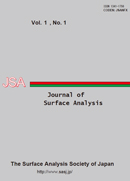Volume 28, Issue 1
Displaying 1-5 of 5 articles from this issue
- |<
- <
- 1
- >
- >|
Preface
-
Article type: Preface
2021Volume 28Issue 1 Pages 1
Published: 2021
Released on J-STAGE: May 15, 2022
Download PDF (129K)
Review
-
Article type: Review
2021Volume 28Issue 1 Pages 2-19
Published: 2021
Released on J-STAGE: May 15, 2022
Download PDF (1683K) -
Article type: Review
2021Volume 28Issue 1 Pages 20-34
Published: 2021
Released on J-STAGE: May 17, 2022
Download PDF (1697K)
Technical Report
-
Article type: Technical Report
2021Volume 28Issue 1 Pages 35-45
Published: 2021
Released on J-STAGE: May 15, 2022
Download PDF (1423K)
Extended Abstract (Review)
-
Article type: Extended Abstract (Review)
2021Volume 28Issue 1 Pages 46-48
Published: 2021
Released on J-STAGE: May 17, 2022
Download PDF (549K)
- |<
- <
- 1
- >
- >|
